|
This section contains 631 words (approx. 2 pages at 400 words per page) |

|
In the middle ages, the emerging nations of Europe used quasi- historical literature to forge national idendities. France's Song of Roland glorified Charlemagne and Frankish valor, while the Arthurian legends captured the English imagination. As paganism gave way to the universalizing force of Christianity, Icelandic poets rescued the Norse gods from oblivion, giving the Scandinavian people a link to their pre-Christian past and a source of ethnic cohesion. For these and other European countries, transferring oral mythology into writing was part of a process of self-definition.
Finland's legends, however, remained unrecorded into the nineteenth century. The church had attempted to banish the ancient Finnish demigods, shaman-heroes, and nature spirits, and centuries of cultural and political domination by Sweden had driven the legends even further to the periphery of the nation's cultural life. Preserved only in the songs of peasants, these myths were unknown to the outside world...
|
This section contains 631 words (approx. 2 pages at 400 words per page) |

|




